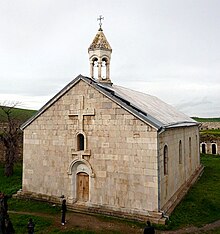Amaras Monastery
| Amaras Monastery | |
|---|---|

The church of St. Grigoris of the Amaras Monastery (established in the 4th century, rebuilt in the 19th century)
|
|
| Basic information | |
| Location | near Sos, Martuni Province, |
| Geographic coordinates | 39°41′02″N 47°03′25″E / 39.684°N 47.057°ECoordinates: 39°41′02″N 47°03′25″E / 39.684°N 47.057°E |
| Affiliation | Armenian Apostolic Church |
| Country | Azerbaijan |
| Website | www.amaras.org |
| Architectural description | |
| Architectural style | Armenian |
| Groundbreaking | 4th-19th century |
Amaras Monastery (Armenian: Ամարաս վանք) is an Armenian monastery in the disputed region of Nagorno-Karabakh, near the village of Sos in the Martuni Province of the Nagorno-Karabakh Republic, de jure in the Khojavend District of Azerbaijan. It was a prominent religious and educational center in medieval Armenia.
According to medieval chroniclers Faustus Byuzand and Movses Kaghankatvatsi, St. Gregory the Illuminator founded the Amaras Monastery at the start of the fourth century.
Amaras was the burial place of St. Gregory the Illuminator's grandson, St. Grigoris (died in 338). A tomb built for his remains still survives under the apse of the nineteenth-century church of St. Grigoris.
At the beginning of the fifth century Mesrop Mashtots, the inventor of the Armenian Alphabet, established in Amaras the first-ever school that used his script.
The monastery was plundered in the thirteenth century by the Mongols, destroyed in 1387 during Tamerlane's invasion, and demolished again in the sixteenth century. It underwent radical restructuring in the second quarter of the seventeenth century when the surviving defensive walls were constructed.
Amaras was later abandoned, and in the first half of the nineteenth century the monastery served as a frontier fortress for Russian imperial troops.
The Armenian Apostolic Church reclaimed the monastery in 1848. The monastery's church appears to have been severely damaged during the period of military occupation, to the extent that a new church had to be constructed on the site of the old one. This new church, dedicated to St. Grigoris, was built in 1858 and paid for by the Armenians of the city of Shusha. It still survives and is a three-nave basilica constructed from bright white stone.
...
Wikipedia
